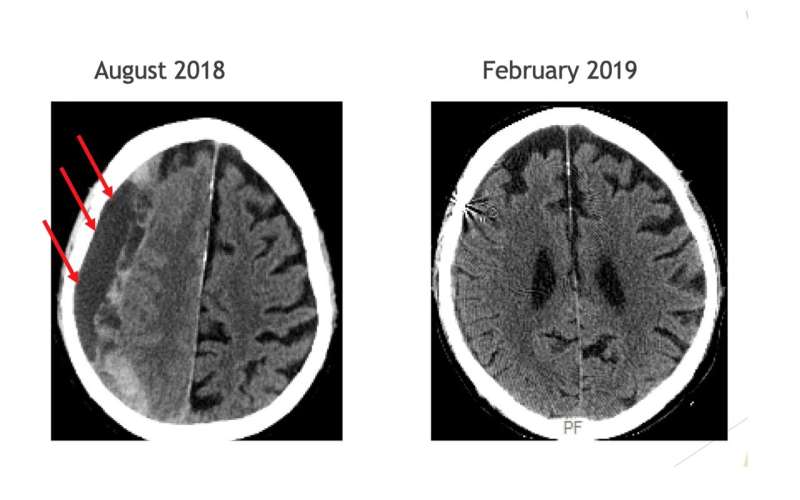June 4, 2024 feature
This article has been reviewed according to Science X's editorial process and policies. Editors have highlighted the following attributes while ensuring the content's credibility:
fact-checked
peer-reviewed publication
trusted source
proofread
Doctors develop minimally invasive procedure to avoid drilling a 'burr hole' in the skull to treat clot on the brain

In 2018, a New York surgeon-scientist and his team demonstrated in a proof-of-concept study that a minimally invasive procedure could effectively treat one of the world's most common conditions requiring neurosurgical intervention.
The condition is called chronic subdural hematoma, an accumulation of blood and blood breakdown products on the brain's surface just beneath the dura, the brain's protective covering. The mass is caused by damaged vessels that chronically leak blood between the brain and the dura. Risk factors for the abnormality, which can reach significant size, include older age; untreated head trauma; long-term use of blood thinning agents, such as warfarin, or extensive time on anti-inflammatory drugs, like ibuprofen.
Now, doctors at Stony Brook Medicine, a division of Stony University on Long Island, report that not only is the new method of alleviating chronic subdural hematoma effective, it's destined to replace the invasive old-school surgery to remove the accumulation of blood.
The new method of treatment is called middle meningeal artery embolization—MMAE—which relies on an injectable fluid to plug the leakage. Studies conducted around the world show that it's safe, effective and eliminates the risks of surgery. Research at Stony Brook led to a global study of the procedure, and doctors have now demonstrated that the new method not only stops the leakage, it forces the hematoma into permanent retreat.
"This is a procedure that will literally change how patients are managed for the most common cranial disease that we treat," Dr. David Fiorella, Global Principal Investigator of the multi-center clinical trial, told Medical Xpress.
Writing in the Journal of NeuroInterventional Surgery, Fiorella and co-author Dr. Adam S. Arthur of the University of Tennessee, emphasized that MMAE "could fundamentally change the treatment paradigm for chronic subdural hematoma, establishing MMAE as a superior alternative therapy."
The standard of care for decades has been surgery, which was designed to provide drainage by drilling a burr hole into the skull or performing a craniotomy, the surgical removal of a portion of the skull to release accumulated blood. While these procedures can alleviate the mass, a chronic subdural hematoma can recur despite the highly invasive attempt to eliminate it. The recurrence rate runs as high as 20%, studies have shown.
Worse, surgery is often poorly tolerated by a broad population of patients: people with heart and pulmonary conditions as well as older people, particularly those on blood thinning agents. One-year mortality rates post-surgery can be as high as 30% for high-risk patients, data show.
Fiorella, a pioneer in neuro-interventional procedures, describes chronic subdural hematoma as an insidious condition, developing slowly, often over weeks to months. The mass can put pressure on the brain causing a range of symptoms: slurred speech, forgetfulness, impaired motor function, even coma.
He said the condition is "probably an underdiagnosed cause of dementia." But the good news is that dementia stemming from a chronic subdural hematoma is usually reversible.
A classic portrait of a patient with chronic subdural hematoma tends to be of an older person. As the mass increases in size, patients begin experiencing the devastating effects. "These patients usually present with headache and pressure and may not be as talkative as they had been," Fiorella said, referring to diminishing speech capacity.
The new approach uses a specialized fluid that is injected into the middle meningeal arteries through a micro-catheter. The liquid embolic agent blocks—embolizes—the abnormal blood vessels that are responsible for the chronic leakage of blood onto the brain's surface. The liquid embolic agent solidifies once it enters the vasculature. Doctors view each step of the procedure via imaging technology.
Fiorella's research led to the international clinical trial called STEM (Squid Trial for the Embolization of the Middle Meningeal Artery for Treatment of Chronic Subdural Hematoma). The agent that blocks the leakage is known as Squid (and has nothing to do with the sea creatures).
The enormous potential of a minimally invasive procedure that is safe and effective has captured the attention of neurosurgeons around the world. In research not connected with the Stony Brook analysis, physicians at Hospital Clínico San Carlos in Madrid wrote in the journal RadioGraphics that MMAE is a promising approach.
The Madrid team collaborated with colleagues in Thailand to assess the effectiveness of the minimally invasive procedure and concluded that MMAE is the way chronic subdural hematoma will eventually be treated worldwide.
"Chronic subdural hematoma is a prevalent medical condition with potentially severe consequences if left untreated," Perez-Garcia and Dr. Angela H. Schmolling wrote in RadioGraphics.
"While surgical removal has traditionally been the standard approach for treatment, middle meningeal artery embolization has emerged as a promising minimally invasive alternative to reduce recurrences," Perez-Garcia and Schmolling added.
Fiorella's STEM trial, which began in November 2020, enrolled 310 patients and was completed in May 2023. Results from the clinical trial were announced at the International Stroke Conference in February 2024.
"I believe these results are potentially a game-changer for the treatment of chronic subdural hematoma," Fiorella concluded. "This new minimally invasive procedure may ultimately save and improve the lives of many thousands of patients worldwide."
More information: David Fiorella et al, Middle meningeal artery embolization for the management of chronic subdural hematoma: what a difference a few years make, Journal of NeuroInterventional Surgery (2023). DOI: 10.1136/jnis-2023-020498
Arindam Rano Chatterjee, Invited Commentary: A New Era in the Treatment of Chronic Subdural Hematomas, RadioGraphics (2024). DOI: 10.1148/rg.240038
© 2024 Science X Network



















